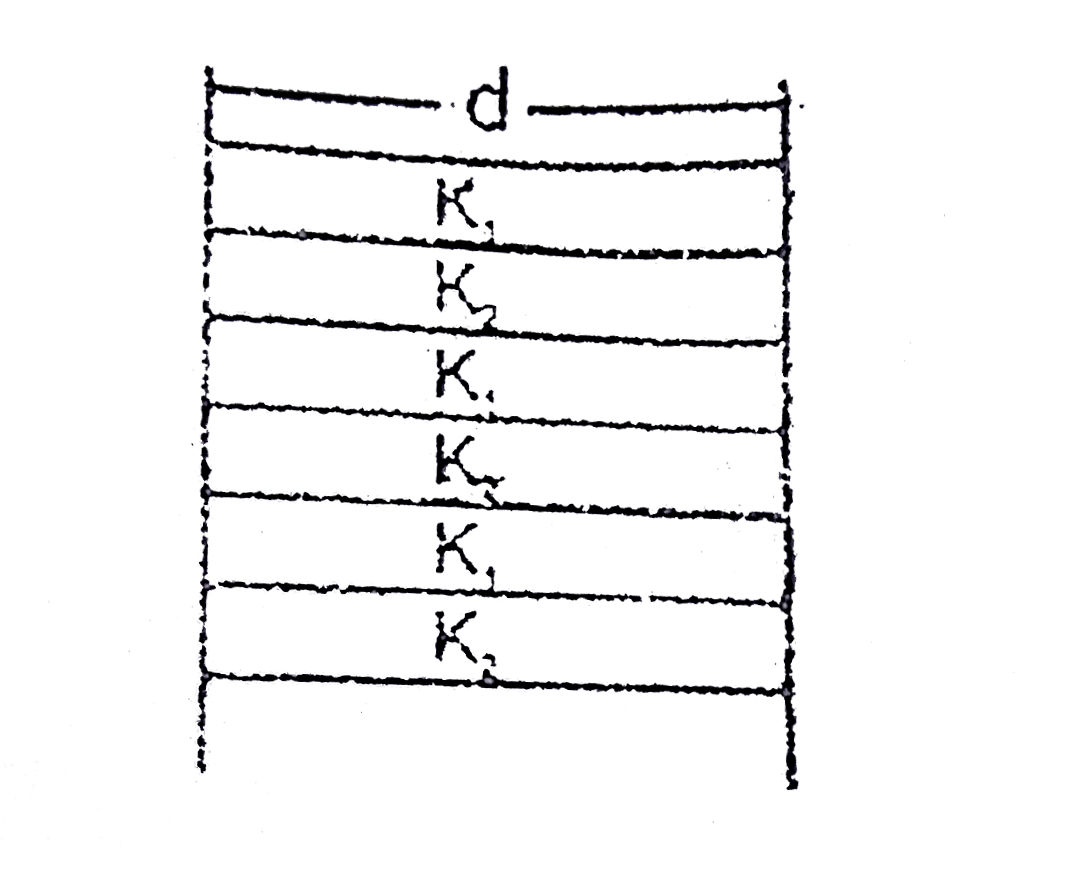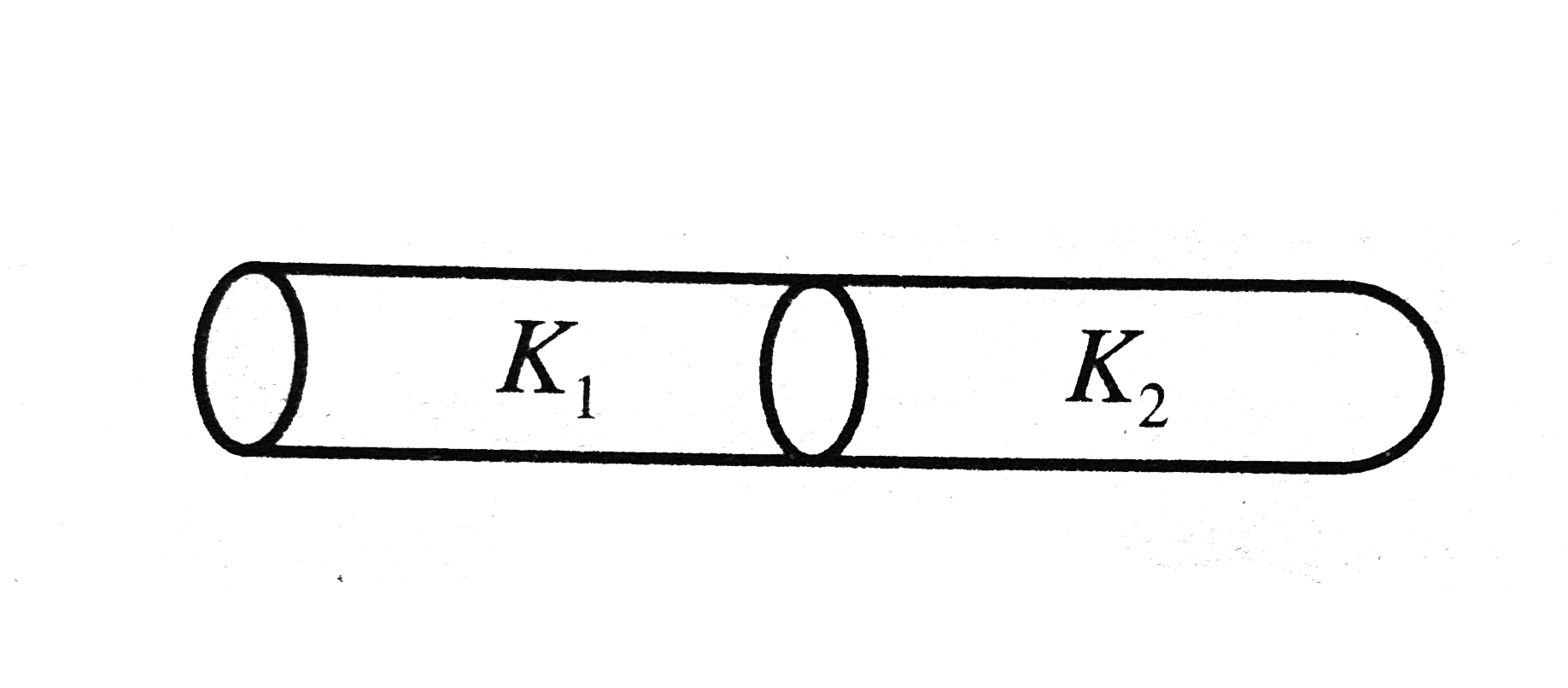Two rods of length l and 2l thermal conductivities 2K and K are connected end to end. If cross sectional areas of two rods are eual, then equivalent thermal conductivity of the system is .
(5/6)K
1.5K
1.2K
(8/9)K
The correct Answer is:C
To find the equivalent thermal conductivity of the system formed by two rods connected end to end, we can follow these steps:
Step 1: Identify the parameters of the rods
- Rod 1:
- Length (L1) = l
- Thermal conductivity (K1) = 2K
- Cross-sectional area (A) = A (same for both rods)
- Rod 2:
- Length (L2) = 2l
- Thermal conductivity (K2) = K
- Cross-sectional area (A) = A (same for both rods)
Step 2: Calculate the thermal resistance of each rod
The thermal resistance (R) of a rod is given by the formula:
R=LK⋅A
- For Rod 1 (R1):
R1=L1K1⋅A=l2K⋅A
- For Rod 2 (R2):
R2=L2K2⋅A=2lK⋅A
Step 3: Combine the thermal resistances
Since the rods are connected end to end, the total thermal resistance (R_total) is the sum of the individual resistances:
Rtotal=R1+R2
Rtotal=l2K⋅A+2lK⋅A
Step 4: Simplify the expression for total resistance
To combine the fractions:
Rtotal=l2K⋅A+4l2K⋅A=l+4l2K⋅A=5l2K⋅A
Step 5: Relate total resistance to equivalent thermal conductivity
The equivalent thermal resistance (R_eff) can also be expressed in terms of the equivalent thermal conductivity (K_eff):
Reff=LtotalKeff⋅A
Where Ltotal=l+2l=3l.
Setting the two expressions for resistance equal:
5l2K⋅A=3lKeff⋅A
Step 6: Solve for equivalent thermal conductivity (K_eff)
Cancel out common terms (l and A):
52K=3Keff
Cross-multiply to solve for K_eff:
5Keff=6K
Keff=6K5
Final Answer
The equivalent thermal conductivity of the system is:
Keff=1.2K
---
- Rod 1:
- Length (L1) = l
- Thermal conductivity (K1) = 2K
- Cross-sectional area (A) = A (same for both rods)
- Length (L2) = 2l
- Thermal conductivity (K2) = K
- Cross-sectional area (A) = A (same for both rods)
The thermal resistance (R) of a rod is given by the formula:
R=LK⋅A
R1=L1K1⋅A=l2K⋅A
R2=L2K2⋅A=2lK⋅A
Since the rods are connected end to end, the total thermal resistance (R_total) is the sum of the individual resistances:
Rtotal=R1+R2
Rtotal=l2K⋅A+2lK⋅A
To combine the fractions:
Rtotal=l2K⋅A+4l2K⋅A=l+4l2K⋅A=5l2K⋅A
The equivalent thermal resistance (R_eff) can also be expressed in terms of the equivalent thermal conductivity (K_eff):
Reff=LtotalKeff⋅A
Where Ltotal=l+2l=3l.
5l2K⋅A=3lKeff⋅A
Cancel out common terms (l and A):
52K=3Keff
5Keff=6K
Keff=6K5
The equivalent thermal conductivity of the system is:
Keff=1.2K
Topper's Solved these Questions
- TRANSMISSION OF HEATBook:NARAYNAChapter:TRANSMISSION OF HEATExercise:LEVEL-III (C.W)
Explore 1 Video
- TRANSMISSION OF HEATBook:NARAYNAChapter:TRANSMISSION OF HEATExercise:LEVEL- (C.W)
Explore 25 Videos
- TRANSMISSION OF HEATBook:NARAYNAChapter:TRANSMISSION OF HEATExercise:LEVEL - 2 (C.W)
Explore 1 Video
- THERMODYNAMICSBook:NARAYNAChapter:THERMODYNAMICSExercise:Exercise
Explore 187 Videos
- UNITS AND MEASUREMENTSBook:NARAYNAChapter:UNITS AND MEASUREMENTSExercise:STATEMENT TYPE QUESTION
Explore 23 Videos
Similar Questions
A composite slab is prepared by pasting two plates of thickness L1 and L2 and thermal conductivites K1 and K2 . The slab have equal cross-sectional area. Find the equivalent conductivity of the composite slab.
View SolutionA wall consists of alternating blocks withlength 'd' and coefficient of thermal conductivity k1 and k2. The cross sectional area of the blocks are the same. The equivalent coefficient of thermal conductivity of the wall between left and right is:-

View Solution
Knowledge Check
Three rods of lengths L,21 and 3L having thermal conductivities 3K,2K and K are connected end to end If cross sectional areas of three rods are equal If cross sectional areas of three rods are equal then equivalent thermal conductivity of the system is .
A18K/13B36K/133C9K/13D12K/13 Statement I: Two solid cylindrical rods of identical size and different thermal conductivity K1 and K2 are connected in series. Then the equivalent thermal conductivity of two rods system is less than that value of thermal conductivity of either rod.
Statement I: Two solid cylindrical rods of identical size and different thermal conductivity K1 and K2 are connected in series. Then the equivalent thermal conductivity of two rods system is less than that value of thermal conductivity of either rod.
Statement II: For two cylindrical rods of identical size and different thermal conductivity K1 and K2 connected in series, the equivalent thermal conductivity K is given by 2K=1K1+1K2AStatement I is true, Statement II is true and Statement II is the correct explanation for statement I.BStatement I is true, statement II is true and statement II NOT the correct explanation for Statement ICStatement I is true, Statement II is false.DStatement I is false, statement II is true.A wall consists of alternating blocks withlength 'd' and coefficient of thermal conductivity k1 and k2. The cross sectional area of the blocks are the same. The equivalent coefficient of thermal conductivity of the wall between left and right is:-
 AK1+K2B(K1+K2)2CK1+K2K1+K2D2K1+K2K1+K2
AK1+K2B(K1+K2)2CK1+K2K1+K2D2K1+K2K1+K2
Two rods of length d1 and d2 and coefficients of thermal conductivites K1 and K2 are kept touching each other. Both have the same area of cross-section. The equivalent thermal conductivity.
View SolutionTwo rods of the same length and diameter, having thermal conductivities K1 and K2, are joined in parallel. The equivalent thermal conductivity to the combinationk is
View SolutionTwo rods of the same length and diameter having thermal conductivities K1 and K2 are joined in parallel. The equivalent thermal conductivity of combination is
View SolutionTwo rods of the same length and diameter having thermal conductivities K1 and K2 are joined in parallel. The equivalent thermal conductivity of combination is
View SolutionA metal rod of area of cross section A has length L and coefficient of thermal conductivity K the thermal resistance of the rod is .
View Solution
